What is a stairlift?
A stairlift is a motorized chair that moves along a rail installed on a staircase, helping people with mobility challenges get up and down safely. Whether for aging in place, recovering from surgery, or managing a disability, stairlifts provide independence and ease of movement within the home.
They come in different designs to fit various staircases — straight, curved, or outdoor — and can be customized with features like swivel seats, safety belts, and remote controls. Some stairlifts require installation, while others are portable for flexible use.
If stairs have become a daily struggle, a stairlift can help make your home accessible again.
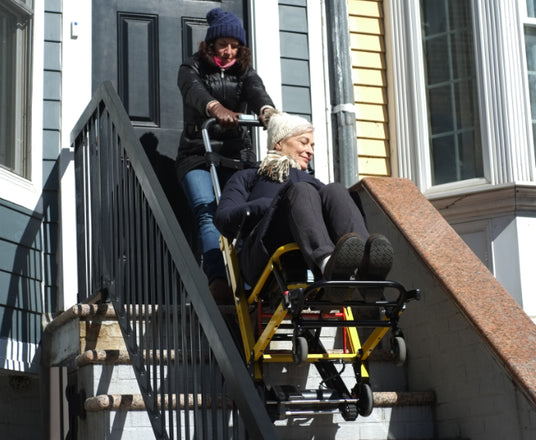
Through convenience and ease-of-use, a stairlift grants people with disabilities or balance issues more freedom in their own home. In addition to helping with daily activities, there are a number of other notable situations in which a stairlift proves its movement mettle.
For example:
- Outings are less of a chore because spontaneous trips require less planning.
- Should an emergency occur, a stairlift aids in quick, efficient evacuation.
- Emergency teams outfitted with mobile stairlifts can move and treat more people in an emergency situation.
- Many stairlifts are safe for children and can be used in school facilities and on school grounds.
We’ve only scratched the surface. However, before we go into greater detail, we’d like to establish upfront that we offer mobile stairlifts catering to the above needs. But in the interest of helping you find the stairlift that’s perfect for you or your loved one, we’ve created this informational resource to help guide your decision.
Who Are Stairlifts For?
Stairlifts are for anyone who finds stairs challenging due to age, injury, or a medical condition. If climbing steps feels risky, exhausting, or painful, a stairlift can make your home safer and more accessible.
Even professionals like first responders use mobile stairlifts to transport patients safely during emergencies. No matter your situation, if stairs have become a challenge, a stairlift can help you regain confidence and freedom in your own home.
They’re invaluable for:
Types Of Stairlifts and How to Choose the Right One
There are many options, from straight stairlift models to curved stairlifts, each with different mobility and safety features developed for specific lifestyles and locations. The difficulty, however, lies in choosing the stairlift that’s right for you or your loved one’s unique circumstances.
The information below is intended to inform and guide you to the best purchase decision for you.
Straight, Seated Stairlifts
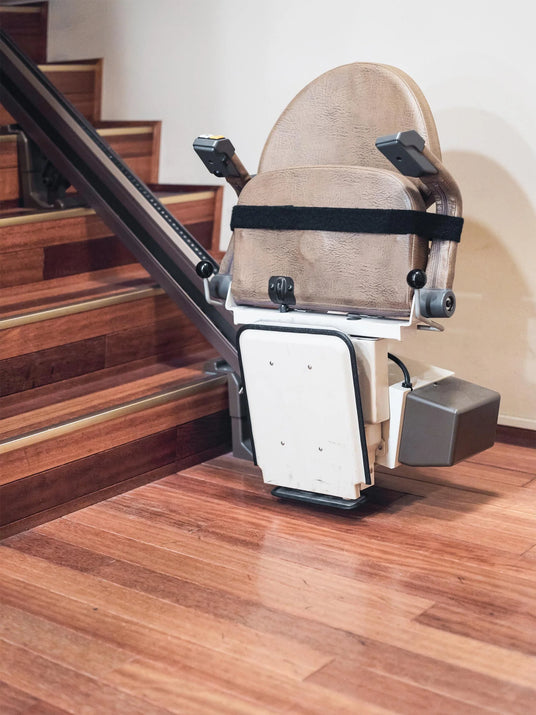
Features and key components
AA straight-seated stairlift is the most common form of multi-level mobility in a domestic setting with uncurved staircases. This type of mobility equipment is for people who cannot walk unaided and require the assistance of a caregiver, or struggle to stand for prolonged periods of time.
This type of stairlift features:
- A switch panel situated in the armrest to control the stairlift’s movement.
- A swivel seat to get in and out of the chair easily. Some have a mechanical swivel function for people who struggle to move the seat manually.
- Textured footrest to mitigate slippage.
- Call-send panel on either end of the staircase.
Installation
The time it takes to install a straight seated stairlift depends on the level of customization required. If it’s minimal, you can expect to have a working system within a day or two, but if the technician has to shorten or make additions to the rail, it will take longer.
Maintenance and service
Once installed, it will need to be serviced by a qualified technician annually. With regards to warranty, be on the lookout for companies that offer free yearly servicing and round-the-clock emergency call-out. As there is no fixed industry standard for warranty and coverage, make sure to read the small print to see what the contract covers.
Standing / Perching Stairlifts
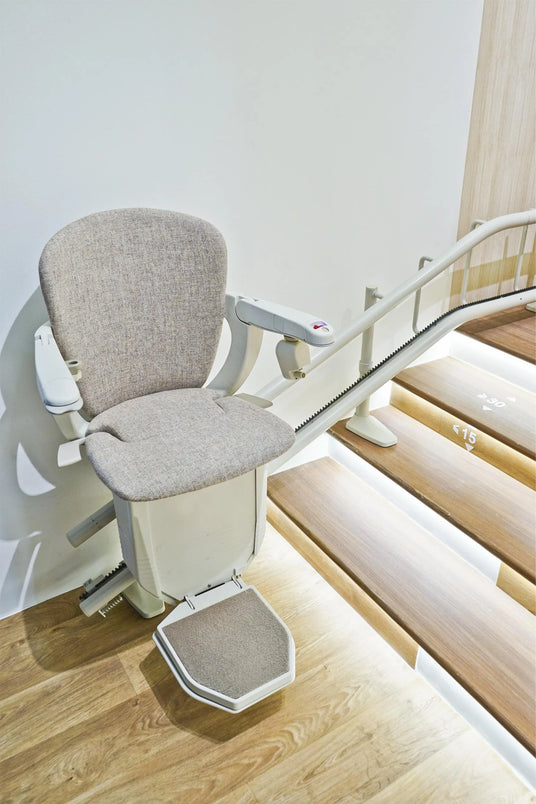
Features and key components
A perched stairlift is for those who can walk to the stairs without help and stay upright as the device moves between floors. Though users will need to bear the majority of their body weight, additional support is offered by a raised seat, a footplate and armrests/guard rails that allow them to ‘perch’ as the stairlift moves along the tracks.
Installation
A standing/perched stairlift is easier to install than the standard seated stairlift. It’s a relatively simple procedure that can be completed within a day by a qualified technician.
Maintenance and service
A standing/perched stairlift will need to be serviced by a qualified engineer annually. Warranty varies greatly, and depending on which brand you choose, you could be looking at anything from a lifetime warranty for motors and gearboxes, and two-to-three years on stairlift parts.
Curved, Seated Stairlifts
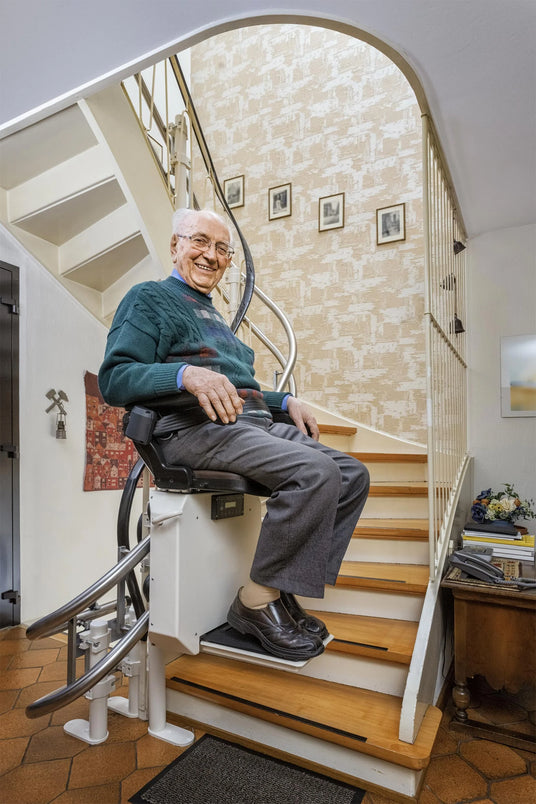
Features and key components
This type of stairlift uses a curved rail system to map the bends of a staircase and navigate corners smoothly. As they can be customized to travel over landings, a curved stairlift is a great option for homes with more than two levels.
Its key components are:
- Most curved stairlifts are battery-operated with charging points at either end.
- Levelling functionality for balance as the chair navigates bends.
- The majority have footrests and folding arms.
Installation
Curved stairlift installation will depend on the specifications of your particular set of stairs. If your staircase structure is complex, it could take a few weeks to receive complete plans. Following this,
a technician will need to customize the curved stairlift to make sure it fits correctly. As installation is more technical than that of a straight stairlift, you’re looking at a few days for installation completion.
Maintenance and service
As with other variants, an annual full service conducted by a qualified technician is necessary to ensure the curved stairlift is running optimally. Before you purchase, however, make sure to go over the warranty agreement with a fine-tooth comb to see what it covers. Some companies offer free annual servicing, which is incredibly cost-effective in the long run.
Stairlift Rental
If you require one for a short period of time, then stairlift rental is a potential option. In general, a rental costs significantly less than purchasing one, though you’re still probably looking at fees for installation and monthly services. Some rental stairlift companies may also require a deposit.
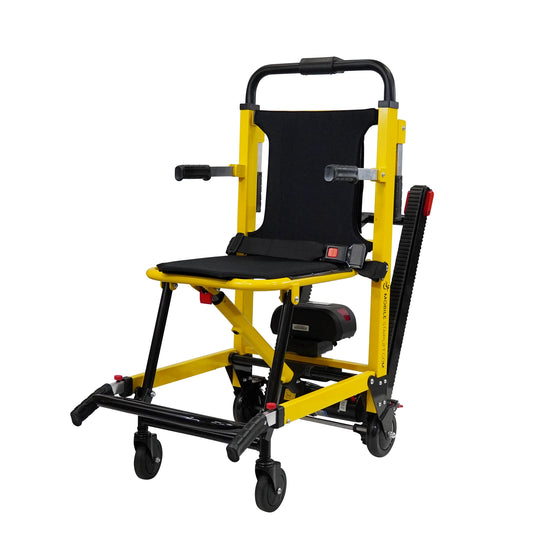
Stairlift rental is most beneficial to those who are temporarily disabled or who will be relocating soon. Cost-wise, you’re looking at between $200 and $500 for a straight stairlift, and in the region of $1500 to $5,000 for a pre-owned stairlift. As curved and outdoor stairlifts require customization, you’ll only be able to purchase those new.
We go into greater detail about the difference between renting or buying a stairlift in one of our recent articles.
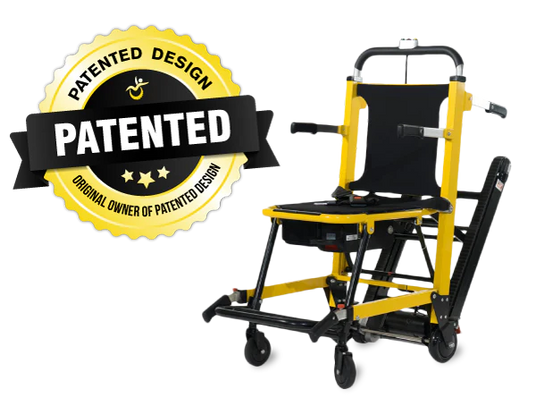
What are your Next(Stairlift) Steps?
If you have any further queries on which stairlift is right for you, or would like more information on the Mobile Stairlift.









